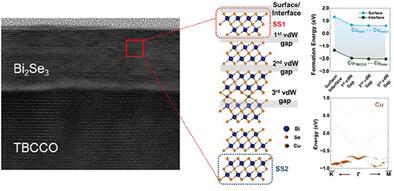当前位置:
X-MOL 学术
›
Adv. Electron. Mater.
›
论文详情
Our official English website, www.x-mol.net, welcomes your feedback! (Note: you will need to create a separate account there.)
Effect of the Post‐Annealing Temperature on the Interfacial Reaction Between a High TC Superconductor and Topological Insulator
Advanced Electronic Materials ( IF 6.2 ) Pub Date : 2024-04-10 , DOI: 10.1002/aelm.202300870 Woo‐Jung Lee 1, 2 , Tae‐Ha Hwang 1 , Dae‐Hyung Cho 1, 2 , Kwangsik Jeong 3 , Soyoung Lim 1 , Rina Kim 1 , Yong‐Duck Chung 1, 2
Advanced Electronic Materials ( IF 6.2 ) Pub Date : 2024-04-10 , DOI: 10.1002/aelm.202300870 Woo‐Jung Lee 1, 2 , Tae‐Ha Hwang 1 , Dae‐Hyung Cho 1, 2 , Kwangsik Jeong 3 , Soyoung Lim 1 , Rina Kim 1 , Yong‐Duck Chung 1, 2
Affiliation

|
This work reports the formation of a heterojunction composed of Tl2 Ba2 CaCu2 O8 (Tl‐2212) and Bi2 Se3 as the high critical temperature superconductor and topological insulator, respectively. The Bi2 Se3 film is deposited on the Tl‐2212 by a chemical mechanical polishing process. Due to the rough surface of Tl‐2212, the treated Tl‐2212 is then subjected to post‐annealing at various temperatures. This temperature does not affect the formation of the interfacial layer at the heterojunction; however, an improved layered crystal structure of the Bi2 Se3 film is observed at 500 °C. The in‐depth profile of the relative atomic concentration indicates the diffusion of Cu and Tl into the Bi2 Se3 film with the Ba diffusion being closer to the interfacial layer. At 500 °C, Cu atoms are more actively diffused into the Bi2 Se3 film, thus blocking Tl diffusion, and improving the layered crystal structure of the film. The density functional theory calculations reveal that the lowest formation energy of the Cu vacancy is when Bi2 Se3 is in contact with Tl‐2212, which results in the diffusion of Cu atoms from Tl‐2212, thus transforming the interstitial Cu atoms into the film. These atoms have an n‐type doping effect and prefer intercalating at a vdW gap deep inside the layered Bi2 Se3 .
中文翻译:

后退火温度对高TC超导体与拓扑绝缘体界面反应的影响
这项工作报告了由 Tl 组成的异质结的形成2 巴2 钙铜2 氧8 (Tl-2212) 和 Bi2 硒3 分别作为高临界温度超导体和拓扑绝缘体。毕2 硒3 通过化学机械抛光工艺在 Tl-2212 上沉积薄膜。由于Tl-2212的表面粗糙,处理后的Tl-2212随后在不同温度下进行后退火。该温度不影响异质结处界面层的形成;然而,Bi的层状晶体结构得到了改进2 硒3 在 500 °C 下观察薄膜。相对原子浓度的深入分布表明 Cu 和 Tl 扩散到 Bi 中2 硒3 Ba 扩散更接近界面层的薄膜。在 500 °C 时,Cu 原子更积极地扩散到 Bi 中2 硒3 薄膜,从而阻挡Tl扩散,改善薄膜的层状晶体结构。密度泛函理论计算表明,当 Bi 存在时,Cu 空位的形成能最低。2 硒3 与Tl-2212接触,导致Cu原子从Tl-2212扩散,从而将间隙Cu原子转变成薄膜。这些原子具有 n 型掺杂效应,并且更喜欢嵌入层状 Bi 深处的 vdW 间隙处2 硒3 。
更新日期:2024-04-10
中文翻译:

后退火温度对高TC超导体与拓扑绝缘体界面反应的影响
这项工作报告了由 Tl 组成的异质结的形成



























 京公网安备 11010802027423号
京公网安备 11010802027423号